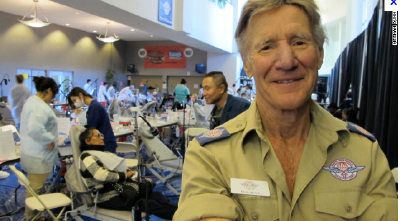British-born Stan Brock, the founder of RAM (Remote Area Medical Foundation), worked on the savannah of Guyana as a cowboy on one of the largest cattle ranches in the world. He grew-up with the Wapishana and other tribes who live on the border of the Amazon rainforest. He mastered their languages, became an expert on rain forests and their inhabitants, and even discovered a new species of bat.
Stan witnessed the near devastation of whole tribes by minor illnesses because of lack of access to the most basic medical care. In 1953, Stan nearly died when a horse kicked him in the head; the nearest doctor was 26 days away on foot. ‟I survived malaria, dengue fever, and leishmaniasis without the help of a doctor, but others were not so lucky and I buried a number of them.” He vowed to bring proper medical facilities to this and other remote areas. He got his pilot’s license and a small plane and began bringing medical aid to the people, and even the animals, in this isolated region.
The producers of ‟Wild Kingdom”, a popular American television show, were impressed when he wrestled an anaconda on camera.(1) Soon he became famous as the man who could grapple giant snakes in Amazonian watering holes and face down roaring lions on the African plains. But fame was not what he was looking for: ‟I decided: enough of this nonsense; it’s time to do something worthwhile.”
So Stan sold everything he owned and created RAM, a charity that delivers free medical treatment to Guyana’s jungles and to other remote places.
In 1992, RAM expanded to deliver health care to countless disadvantaged Americans who simply could not afford it. ‟It’s very sad that the state of affairs requires us to provide this kind of care in the world’s richest country.” RAM became the only nongovernmental charitable organization in the United States that offers free dental, free eye-care, and free medical help without any restrictions or questions asked. They also offer veterinary care to companion animals.
RAM has now provided healthcare to over half a million patients in the United States through vast mobile health clinics run by an army of volunteers travelling with trucks, equipment, dental chairs, and medical supplies. Overnight they set up facilities in vacant lots, warehouses, wherever they can find the space. At 5:30 in the morning, the doors open to the thousands of patients who have queued overnight.
Teresa Casey, 48, after a six-year struggle with cancer and a degenerative bone disease, did not have the hundreds of dollars she would need to buy dentures. ‟That’s my whole income,” she said. She was a lucky recipient of RAM’s services. Health coverage in the United States is a complex labyrinth that is brutal to navigate. The bottom line is that millions of Americans who are working still cannot afford the cost of healthcare.(2)
Hundreds of volunteers pay their own expenses and supplement supplies with their own equipment for the privilege of providing free care to those in need. As Stan says, ‟We operate entirely on the generosity of the American people. I’d like to say that we had big corporate support in America, but we don’t. So it’s the little checks from those people who send in the $5 and $10.”
Over the years, more than 70,000 people have donated their time and expertise to Stan’s foundation. Many are full-time doctors and nurses who work at their own practices or hospitals and volunteer on weekends. RAM runs about 25 clinics a year, serving hundreds of patients at a time.
Stan Brock does not have a house and salary; he has no bank account, no possessions. He sleeps on the floor of his office, works 365 days a year, and lives on rice, beans, and fruit. He laughingly admits he has taken a vow of poverty as part of his philanthropy. ‟I guess I’m your basic indigent CEO,” he laughs.” He is also humble, quick to deflect praise to the volunteers who have helped throughout the years. ‟It’s those people that are making these patients either pain-free or more functional and better,” he said. ‟They’re the heroes. All I do is show up and carry some of the luggage.”
Part Indiana Jones, part Gandhi, he seems incapable of wasting time. He is often the pilot of the small planes that bring medical professionals and supplies to Indian tribes in Guyana, and of the World War II vintage cargo plane loaded with dental chairs for a clinic in the hills of Tennessee. There are a total of five aircraft in the donated fleet.
Now 77 years old, Stan leads these missions with the same vigor he has always had. He is everywhere: asking questions, checking procedures, delegating tasks, moving with purpose. ‟This is all I do. This is my passion. It’s the most important thing to me.”
(1) http://www.youtube.com/watch?v=T8s_g2v9M1
(2) See Guy Adams, ‟The brutal truth about America’s healthcare” The Independent, 15 August 2009. Allie Torgan, ‟Former cowboy flying free health care to those in need” CNN Heroes, April 6, 2012. Ariel Leve, ‟Saint Stan Brock: who are you?” London Times Online, 5 April 2009.
